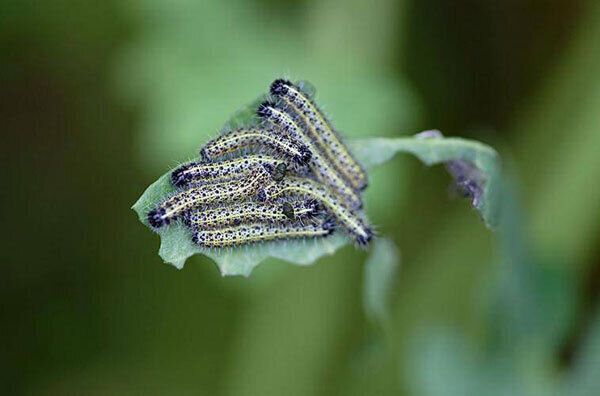Countering the dastardly cabbage white butterfly

Cabbage whites are our most common butterfly and most common vegetable garden pest. They are the first to emerge and last to hibernate and so seem to be around all spring and summer. Endless.
However, I still find them attractive (visibly) even though I know they are a danger to my cabbage family crops. I know I have to deal with them or my larder shrinks.
So as they are readying to emerge this week. A closer look is timely.
There are two types: the Small White, Pieris rapae and the Larger White, Pieris brassicae.
The Small White emerges over February and March and the Large White emerges through March and April.
Both will last until October/November, but not before multiple batches of eggs add multitudes of caterpillars. (and eventually new adults), to swell the ranks.
March was the month the ancient Fianna returned to war training and when it comes to garden pests now is definitely the time to get on a war footing.

In terms of knowing your enemy, the Large and Small definition is a bit deceptive. Both are similar in scale and appearance — about 5cm wingspan, whitish topsides bearing black tracery, charcoal tips and distinctive spots, undersides tinged yellowish-green.
Males bear one spot per wing; females display two. Spring brood males have greyer wingtips than summer brood counterparts. Spring brood females are shaded lighter than summer counterparts.
The butterflies don’t do any physical damage to your crops, it’s their young that do that.
So egg and caterpillar identification is key; the large species lays neatly arranged clutches of bright yellow skittle-shaped eggs on top and bottom surfaces of foliage, hatching into hairy, yellow and black caterpillars.
The small white lays singly underneath leaves, pale eggs turning yellow then grey, caterpillars hatch bright velvety-green.
Seeing the adult is just the reminder that action is needed — don’t see a white flag of peace or surrender — see it as a flare to signal the war.
Adults take nectar, not foliage, but the young take copious foliage — from simple punch holes spotted during the day to a whole plant, denuded overnight.
They excrete dark green or brown granular deposits, literally fouling up the plant and rendering it inedible, prone to rot and disease. The large caterpillars are less palatable to birds, so openly feed on surfaces.
The smaller juicier caterpillars have adapted to hide underneath and burrow into the hearts of cabbages to feed, triggering rot from within.

Insectivorous birds only go so far in taking down their populations, but every little helps and a birdbox or perching opportunities about the garden is one for the to-do list.
Beetles will take eggs and hedgehogs will devour the caterpillars, so a log pile and a leaf litter area of the garden is of great benefit too.
I like the notion of my enemy’s enemy when it comes to pest control and I will return to it in the coming seasons. I just don’t trust chemicals, so integrated pest management is the way for me.
Apart from befriending some wildlife allies you can also employ fleece barriers (the gauge of net to keep butterflies out is not always available or attractive) but if you can get it go for it.
We want to stop the butterfly laying at all costs. So as the name suggests cabbage whites are a pest of Brassicaceae crops — that’s cabbage, cauliflower, broccoli, Brussels sprouts and so on. All of these are best netted against pigeons, too.
There are some natural solutions Bacillus thuringiensis and garlic sprays spring to mind and both will help, but in truth the bottom line is you wiping eggs off foliage with bare thumb or damp cloth and picking caterpillars off to dispose of — or get the kids and grandkids involved in the hunt — even better. You will get more in an hour than any predator will in a week.
And you won’t have to wait for the BT or garlic to take effect.
If you’re not already familiar with Bacillus thuringiensis it
is a natural occurring, soil-borne bacteria that has been commercially available since the early 1950s as a natural and organic insect control.
Lately the gene of it has cropped up in GMO crops with some added bad press that has spilled over to the organic product too — the jury is still out and new evidence/studies pending.
Bacillus thuringiensis operates by containing a protein crystal which is toxic to a range of insect species particularly caterpillars, cabbage looper and tomato hornworm, but allegedly is harmless to birds, fish, mammals and gardeners .
It comes in a powder or solution to add to the watering can as a foliar feed and in a dusting powder too. I find garlic spray does the trick.
So that’s my go-to deterrant. It is best to spray every few days until there’s no sign of eggs, hatched larvae or munching caterpillars.
It’s not just that the scent deters — it does and it deters the munching caterpillars and the laying butterflies, but it is also a sulphur overdose to the eggs and larvae.
That sulphur is also antifungal and a tonic to your plant’s natural immune system, so there are more benefits than drawbacks.
There still persists the myth that sudsy water will get all pests, but really your suds work by breaking down the protective coating of the exoskeleton of some pests (aphids mainly) and so triggers death through dehydration, or the bubbles actual suffocate the adult insect.
It’s all a bit gruesome, but then, it is war after all. A dash of suds to your garlic spray helps it adhere to the plant and pest.
So as I said at the start, the adult, the butterfly is only a threat in that it lays eggs that hatch into leaf eaters. It itself is a garden pollinator just like every other butterfly.
Be careful with pest controls and traps as they may catch not just the whites but the red admirals, coppers and blues too. Garlic can harm a pest munching ladybird as quickly as it can a pest.
Judiciousness should be next to cleanliness — and beside godliness.












